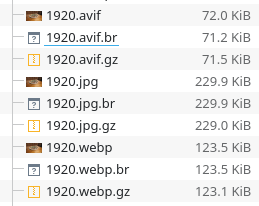but 2KB vs 200KB is paltry on even a terrible connection in the 2000s).
You still need to resize the images and choose the right ones (even if only for the device's performance).
So we might as well do that small extra step and add conversion to the process.
What I really wish is that we could get more browsers, sites, and apps to universally support more modern formats to replace the overly bloated terribly performing and never correctly pronounced animated formats like GIF with something else like AVIF, webm, webp (this was a roughly ~60MB GIF, and becomes a 1MB WEBP with better performance), or even something like APNG…
Isn't that the users' fault? And of the websites for allowing those huge GIFs.
Apparently browsers have supported MP4 for a long time.


Funny you call it magic, what actually does the conversion is Imagick.
In my project I have it integrated in the upload process. You upload a PNG/JPG and it does its thing. Since it's written in PHP (my project), and PHP has an extension to call Imagick, I didn't need to write any complicated code.
You can see on this page if your programming language of choice has any integration with Imagick.
But there's always the command line interface. Depending on your process it may be easier to create a script to "convert all images in a folder", for example.